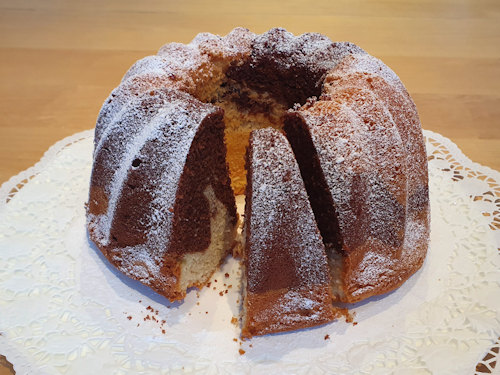
Instantly recognisable thanks to its unique shape, the unobtrusive Gugelhupf enjoys an aristocratic history and a special place in Viennese hearts.
- Sponge-like cake, usually marbled in the Viennese version
- Apparently much loved by Emperor Franz Joseph
- Known for the indented surface and characteristic ring-shaped baking tray
- See also:
What is a Gugelhupf?

(The classic version. I accept full responsibility for the missing piece)
Various recipes exist for this sponge-like cake. But the Gugelhupf’s distinctive characteristics are its shape, colour and texture.
In Vienna, nearly every Gugelhupf you find has two colours (sponge yellow and chocolate brown), giving it the appearance of a marble cake.
Most bakers add a dusting of icing sugar to the finished product; a coffee house or Konditorei (confectionery) may also serve it with whipped cream to take the edge off the relatively dry consistency.
The baking tin (similar to the Bundt mould popular in the USA) is circular with angled grooves on the outside and a Schornstein (“chimney”) in the middle. This gives the Gugelhupf its characteristic outer texture and tall, ring-like shape.

(Various Gugelhupf moulds we use at home)
Although a firm favourite on coffee tables throughout Vienna, the cake’s origins go so far back in history that we can’t say for sure if it’s an Austrian original.
What we do know is that the Gugelhupf’s true home is in Central Europe in general, the lands of the former Austro-Hungarian empire in particular, and the city of Vienna most of all (though places like the Alsace might argue otherwise).
The presence of the classic baking mould throughout history certainly hints at the cake’s age; archaeologists found similar moulds in Roman excavations at Carnuntum, for example, just down the river from Vienna.
Another imperial connection
The defining era, however, for the Gugelhupf was not Imperial Rome but the 19th century, when it migrated from a banal cake to a sort of status symbol served at breakfast or with your mid-morning (or mid-afternoon) coffee or tea.
A big boost to the cake’s social credentials allegedly came from the influence of Kaiser Franz Joseph (1830-1916).

(The classic internal colours)
Scholars associate the reign of Franz Joseph with many notable moments of history. The establishment of Austria-Hungary, for example, or the start of the First World War.
In the kitchens of Vienna, however, people tend to remember the well-moustachioed monarch through his connection to such dishes as Kaiserschmarrn or Tafelspitz.
Gugelhupf appears to be another food that received a thumbs up from the Kaiser. Frankly, he seems to have spread his love of food around a lot of dishes.
The actress, Katharina Schratt (1853-1940), enjoyed a close platonic (or not?) friendship with Franz Joseph. He regularly visited her at home in Vienna or in the country, where (so the story goes) she would serve him Gugelhupf. Hence the association.
True or not, we do know that Gugelhupf enjoyed particularly popularity during the 1800s, especially in Vienna, and it’s from this time that the cake likely inherited a somewhat aristocratic aura that continues today.
Where to get a Gugelhupf in Vienna
It won’t be hard to find. The last Gugelhupf I ate came from a standard bakery chain. Most coffee houses and your local Konditorei should have one.
And, if you happen to be around at Christmas, a booth at the Schönbrunn Christmas market sells lovely miniature Gugelhupf in cellophane wrapping. Though a change of market ownership in 2024 means I can’t be sure that will repeat in future years.
As always, bon appétit.